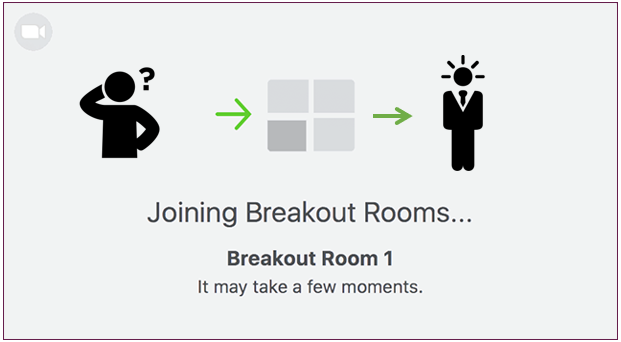Find the programme that meets your requirements and aspirations.
Apply nowStudent Blogs
- SPJIMR
- Blog
- The Breakout room saga!
The Breakout room saga!

Term 1 has gone past in a flash. Sticking to the attributes I gained in engineering (not saying that I’m proud of them), I haven’t retained all the academic learning from Term 1. But I still recall a few Breakout room sessions that were nothing short of being absolutely transformative learning experiences. Oh wait! Before delving into the details, as any responsible author should do, I would like to define the term ‘Breakout room’. The Breakout room is a virtual setup in Zoom, which divides people into smaller groups to discuss a subject matter that only a few of them have heard of, depending on whether they paid heed to the instructions given in the main room. In short, Breakout rooms have a unique ‘positioning’ as they call in marketing when it comes to setting up standards of awkwardness and silence with the expectation that someone out of the blue will start speaking.
So yeah, coming back to the point of the discussion, why does it feel so terribly awkward when these rooms open up? To start with, everyone is pretty new to the format of online classes, and for most of us, it is the first time we encounter each other in person in closed groups. So yeah, that is perhaps the perfect setting for a ‘Tell me about yourself’ type question. Here we go again regurgitating the lines we said during the admission interviews. I am not sure if this breaks the ice, but it successfully eats away our room time, which we would have otherwise spent gazing perplexed at each other’s not so beautiful faces. But the in-class Breakout rooms have an aura of their own. Here we are expected to discuss, debate and arrive at a solution for the case presented moments before in the main room. Rather than a plain text-based explanation, I would again like to show off another peach of an MBA tool, i.e., the ‘2×2 matrix’ – yeah, they never fail to surprise me with the understanding they provide. The matrix here represents the prominent characteristics which participants in Breakout rooms typically adopt.
| Heard and Understood -the task to be carried out in the Breakout room | |||
|---|---|---|---|
| NO | YES | ||
| Switches On the video in the Breakout rooms | NO | The SLEEPY-HEADS -Possible phrase: Why am I with you guys? (mentally) Is the class over? | The BANDWIDTH struggler -Possible phrases: Am I audible? I’ll type it in the chat. |
| YES | The C’MON guy -Possible phrase: Guys we have to get this done We only have 2 minutes left Anyone heard the question? | The SCREEN-SHARER -Possible phrase: I’ll share the screen. Mujhe sab aata h & I heard everything | |
The parameters of understanding and turning the videos on are on the basis of the commonly observed traits, and they are dynamically adopted by the participants in the Breakout rooms depending on the context. Thus, a Screen-Sharer in one room could be a C’mon guy in another and this dynamic adoption of the characteristics could be a topic for another day. Diving into the matrix, we may infer that the null hypothesis would be rejected, i.e., the answers coming out of the discussions and debates in the Breakout rooms would not match the expected value that the Faculty desired. But to my surprise, post the Breakout room saga, we always manage to come up with a solution which either partially or completely aligns with the expected value, and hence we fail to reject the null. This is perhaps the only rejection that makes me feel proud.
You may ask, does this really matter? I reckon it does. Along with the core knowledge, Breakout rooms give us the sense of what it takes to be a manager. We always enter these rooms eager but perplexed, no matter how antithetical it may sound in retrospect. Upon entering the rooms, there is a waiting time for some videos to turn on that eat a part of the throughput time. However, it offers a window for the ‘C’mon guy’ to break in and get everyone focused on the task at hand. The ‘Screen-Sharer’ goes ahead and shares the screen and the ‘Bandwidth Struggler’ with all the difficulties he/she is facing is keen to contribute, to come up with an approach to solve the problem. The three go on discussing and debating while simultaneously asking if the ‘Sleepy Head’ is alive and perhaps a yes from him would assure the team that they are on the right path as there is one person less who opposes them, i.e., one person who supports their discussion. The Breakout rooms are, hence, a replica of a mini corporation, which not only tell us that we are the proponents of our own decisions but also hold us accountable for them.
Recent Posts
- #DoCCDiaries: Community springs in the Bag Guler Panchayat July 9, 2024
- Experiential learning: My month-long advocacy internship with PGDM’s DoCC June 25, 2024
- My journey: Transforming lives through Abhyudaya June 6, 2024
- Discovering cutting-edge applications of AI and ML in the finance sector June 4, 2024
- #DoCCDiaries: Durbar: Fight against stigma for ‘dignity of profession’ May 28, 2024

